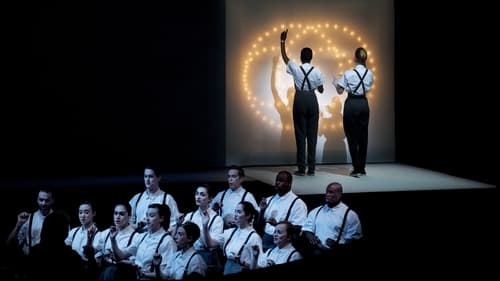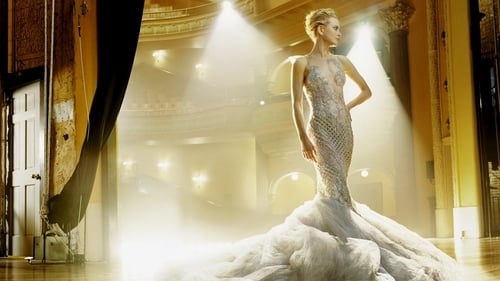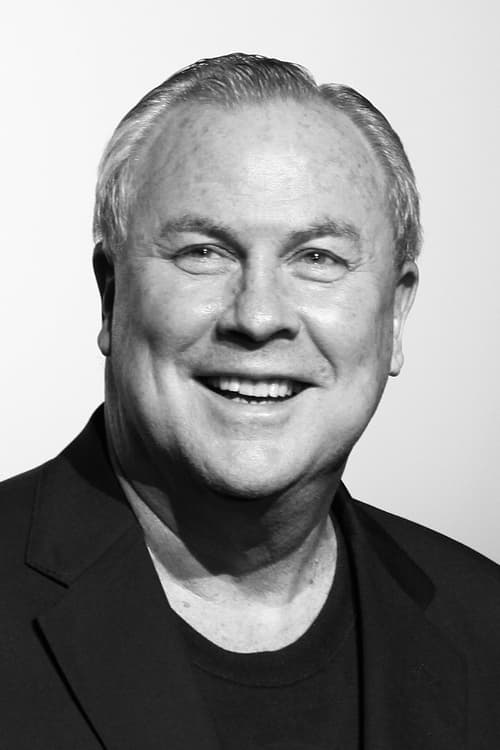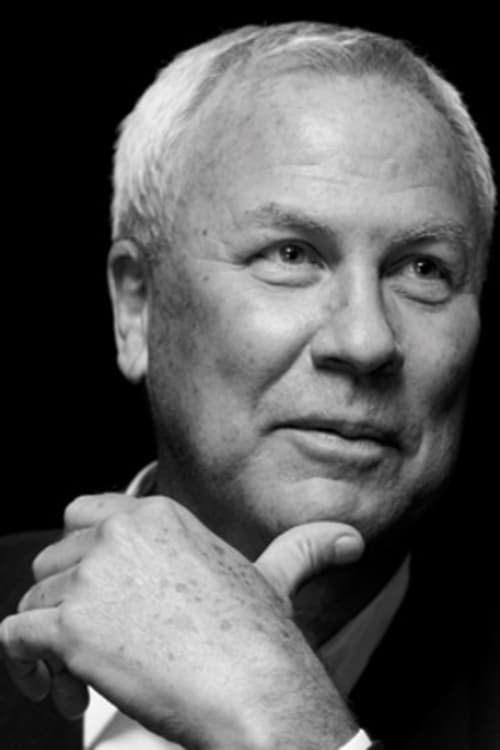
Director
Known as a creator of astonishing images, stage director and visual artist Robert Wilson delivers a magnificent production of Mozart’s adaption of Handel’s Messias. Mozart was commissioned by Gottfried van Swieten to modernise the score fifty years after Handel’s popular composition (1742), mainly by arranging the wind parts and partially re-composing them. With Marc Minkowski a conductor has been engaged who understands perfectly how to combine baroque style with the tonal possibilities of an orchestra of the classical period like the Musiciens du Louvre. The excellent soloist quartet with Elena Tsallagova, Wiebke Lehmkuhl, Richard Croft and José Coca Loza merges perfectly into Wilson’s enormous flood of images.

Lighting Design
After twenty years of absence, Puccini’s Turandot was revived on the stage of the Teatro Real in a new production by American stage director Robert Wilson. One of the most important theatre and visual artist of our times, the director who gave life to Philip Glass’s Einstein of the Beach and who reinvented Debussy’s Pelléas et Mélisande hadn’t worked on a Puccini opera in twenty-five years, since his ground-breaking Madama Butterfly commissioned by the Paris Opera in 1993. This new encounter between his powerful visual universe and Puccini’s evocative music was bound to be an outstanding event. Carried out by a brilliant cast of singers, dominated by Irene Theorin as Turandot, Gregory Kunde as Calaf and Yolanda Auyanet as Liù, this magnificent production is conducted by the Teatro Real’s associate musical director Nicola Luisotti – and has been met with universal acclaim.

Stage Director
After twenty years of absence, Puccini’s Turandot was revived on the stage of the Teatro Real in a new production by American stage director Robert Wilson. One of the most important theatre and visual artist of our times, the director who gave life to Philip Glass’s Einstein of the Beach and who reinvented Debussy’s Pelléas et Mélisande hadn’t worked on a Puccini opera in twenty-five years, since his ground-breaking Madama Butterfly commissioned by the Paris Opera in 1993. This new encounter between his powerful visual universe and Puccini’s evocative music was bound to be an outstanding event. Carried out by a brilliant cast of singers, dominated by Irene Theorin as Turandot, Gregory Kunde as Calaf and Yolanda Auyanet as Liù, this magnificent production is conducted by the Teatro Real’s associate musical director Nicola Luisotti – and has been met with universal acclaim.

Director
After twenty years of absence, Puccini’s Turandot was revived on the stage of the Teatro Real in a new production by American stage director Robert Wilson. One of the most important theatre and visual artist of our times, the director who gave life to Philip Glass’s Einstein of the Beach and who reinvented Debussy’s Pelléas et Mélisande hadn’t worked on a Puccini opera in twenty-five years, since his ground-breaking Madama Butterfly commissioned by the Paris Opera in 1993. This new encounter between his powerful visual universe and Puccini’s evocative music was bound to be an outstanding event. Carried out by a brilliant cast of singers, dominated by Irene Theorin as Turandot, Gregory Kunde as Calaf and Yolanda Auyanet as Liù, this magnificent production is conducted by the Teatro Real’s associate musical director Nicola Luisotti – and has been met with universal acclaim.

Director
"This is a family tragedy, and in many ways, it is a very contemporary story." This is how Robert Wilson described Il trovatore, or Le Trouvère in its French version, commissioned from Verdi after the incredible success of the premiere of his Italian version in 1853. With a few changes and alterations to the original music, this version was first performed in 1857 at the Paris Opera. A light show unique to the stage director unfolds in the cold architecture, creating the perfect framing for Verdi’s music, dramatic and dark in this timeless opera.

Explores some of the most innovative attempts by contemporary artists, filmmakers, architects etc to explore multiple Temporalities and to counter the uniform sense of time promoted by our technology-driven society.

Sound
A Winter Fable is a story told by the triptych of video portraits of a wolf, a fox, and a lamb with a score that is composed of music by Coco Rosie, and readings of the original fable by Italo Calvino’s daughter Giovanna Calvino and her friend Isabella Rossellini. The portraits form a triptych that are linked to each other and synced to the score. To help maintain the autonomy of each portrait and yet create an intimate grouping, Robert Wilson and architect Filippo Moretti designed a room with angled walls, built within one of the stables of Villa Panza.

Director
A Winter Fable is a story told by the triptych of video portraits of a wolf, a fox, and a lamb with a score that is composed of music by Coco Rosie, and readings of the original fable by Italo Calvino’s daughter Giovanna Calvino and her friend Isabella Rossellini. The portraits form a triptych that are linked to each other and synced to the score. To help maintain the autonomy of each portrait and yet create an intimate grouping, Robert Wilson and architect Filippo Moretti designed a room with angled walls, built within one of the stables of Villa Panza.

Lighting Design
Giuseppe Verdi based his famous opera on the novel “The Lady of the Camellias” by Alexandre Dumas. Robert Wilson’s production of Violetta Valéry’s tragic fate is his first work at the State Theater of Linz, Austria, one of the most modern operatic stages in Europe by architect Terry Pawson. After the run in Linz, the production was transferred to the Opera House in Perm, Russia, where the production was conducted by Teodor Currentzis. In 2017, the work received a “Golden Mask”, the most prestigious Russian theater award, in three categories (Teodor Currentzis, Best Conductor; Nadezhda Pavlova, Best Female Singer; Robert Wilson, Best Lighting Design).

Stage Director
Giuseppe Verdi based his famous opera on the novel “The Lady of the Camellias” by Alexandre Dumas. Robert Wilson’s production of Violetta Valéry’s tragic fate is his first work at the State Theater of Linz, Austria, one of the most modern operatic stages in Europe by architect Terry Pawson. After the run in Linz, the production was transferred to the Opera House in Perm, Russia, where the production was conducted by Teodor Currentzis. In 2017, the work received a “Golden Mask”, the most prestigious Russian theater award, in three categories (Teodor Currentzis, Best Conductor; Nadezhda Pavlova, Best Female Singer; Robert Wilson, Best Lighting Design).

Director
Giuseppe Verdi based his famous opera on the novel “The Lady of the Camellias” by Alexandre Dumas. Robert Wilson’s production of Violetta Valéry’s tragic fate is his first work at the State Theater of Linz, Austria, one of the most modern operatic stages in Europe by architect Terry Pawson. After the run in Linz, the production was transferred to the Opera House in Perm, Russia, where the production was conducted by Teodor Currentzis. In 2017, the work received a “Golden Mask”, the most prestigious Russian theater award, in three categories (Teodor Currentzis, Best Conductor; Nadezhda Pavlova, Best Female Singer; Robert Wilson, Best Lighting Design).

Director
Adam’s Passion is the moving first collaboration between two “masters of slow motion who harmonize perfectly with each other” (Frankfurter Allgemeine Zeitung). In the spectacular setting of a former submarine factory, American director and universal artist Robert Wilson creates a poetic visual world in which the mystical musical language of the Estonian composer Arvo Pärt can cast its meditative spell. Three of Pärt’s major works – Adam’s Lament, Tabula rasa, and Miserere, as well as Sequentia, a new work composed especially for this production – are brought together here using light, space, and movement to create a tightly-woven Gesamtkunstwerk in which the artistic visions of these two great artists mirror each other.

Set Designer
Adam’s Passion is the moving first collaboration between two “masters of slow motion who harmonize perfectly with each other” (Frankfurter Allgemeine Zeitung). In the spectacular setting of a former submarine factory, American director and universal artist Robert Wilson creates a poetic visual world in which the mystical musical language of the Estonian composer Arvo Pärt can cast its meditative spell. Three of Pärt’s major works – Adam’s Lament, Tabula rasa, and Miserere, as well as Sequentia, a new work composed especially for this production – are brought together here using light, space, and movement to create a tightly-woven Gesamtkunstwerk in which the artistic visions of these two great artists mirror each other.

Himself
He is the most performed contemporary composer in the world. And yet he rarely ventures out in public, prefers to keep quiet about his music, feels at home in the forests of Estonia and generates therewith - perhaps involuntarily - the impression of a recluse, which is attributed to him again and again: Arvo Part. In The Lost Paradise, we follow him over a period of one year in his native Estonia, to Japan and the Vatican. The documentary is framed by the stage production of Adam's Passion, a music theater piece based on the Biblical story of the fall of Adam featuring three key works by Arvo Part. The world-renowned director Robert Wilson has brought this work to the stage in a former submarine factory in Tallinn. Tracing their creative process, the film offers rare and personal insights into the worlds of two of the most fascinating personalities in the international arts and music scene.

Director
This seminal work of avant-garde opera from composer Philip Glass and director Robert Wilson arrives full-circle, coming to France, the site of its 1976 Avignon Festival world premiere, at the tail end of this 2014 revival tour for a landmark Theâtre du Châtelet production and a first ever filming by award-winning arts filmmaker Don Kent. Eschewing conventional narrative, the opera revolves loosely around pacifist Einstein’s relationship to the creation of the atomic bomb.

Set Designer
This seminal work of avant-garde opera from composer Philip Glass and director Robert Wilson arrives full-circle, coming to France, the site of its 1976 Avignon Festival world premiere, at the tail end of this 2014 revival tour for a landmark Theâtre du Châtelet production and a first ever filming by award-winning arts filmmaker Don Kent. Eschewing conventional narrative, the opera revolves loosely around pacifist Einstein’s relationship to the creation of the atomic bomb.

Director
Debussy's masterpiece, for the first time conducted by the Paris Opera's music director Philippe Jordan, in the fairy staging by Robert Wilson. When Prince Golaud, grandson of King of Allemonde, meets the beautiful Mélisande, he knows nothing about her. Though, he marries her. A few months later, Golaud announces his wedding to his brother Pelléas, who seems to be falling in love with the woman.

Stage Director
Debussy's masterpiece, for the first time conducted by the Paris Opera's music director Philippe Jordan, in the fairy staging by Robert Wilson. When Prince Golaud, grandson of King of Allemonde, meets the beautiful Mélisande, he knows nothing about her. Though, he marries her. A few months later, Golaud announces his wedding to his brother Pelléas, who seems to be falling in love with the woman.

Himself
This hourlong semi-documentary records the musical stage collaboration between director Robert Wilson and veteran performance artist Marina Abramovic. Also included is a wealth of background material about Abramovic's life and earlier works.

Self
A captivating history of the nation's oldest performing arts center - which largely mirrors the evolution of experimental and progressive performing arts in 20th century America - BAM150 chronicles the vibrant past, present and future of the Brooklyn Academy of Music. Through footage of recent performances, intimate interviews, and an astonishing treasure trove of 150 years' worth of archival materials, BAM150 is a testament to the power and stamina of the institution that established Brooklyn as a cultural mecca-serving as a home to such greats as Enrico Caruso, Sarah Bernhardt, Edwin Booth, Merce Cunningham, Robert Wilson, Mark Morris, Laurie Anderson, and Pina Bausch.

Himself

Director
US stage director Robert Wilson has teamed up with pop star Rufus Wainwright to bring Shakespeare’s sonnets to the stage in Berlin. Debuting on Easter Sunday, this highly stylized cross-dressing version of the archetypal love poems went down a storm with the audience.

Production Design
US stage director Robert Wilson has teamed up with pop star Rufus Wainwright to bring Shakespeare’s sonnets to the stage in Berlin. Debuting on Easter Sunday, this highly stylized cross-dressing version of the archetypal love poems went down a storm with the audience.

Writer
US stage director Robert Wilson has teamed up with pop star Rufus Wainwright to bring Shakespeare’s sonnets to the stage in Berlin. Debuting on Easter Sunday, this highly stylized cross-dressing version of the archetypal love poems went down a storm with the audience.

Lighting Director
Rinaldo Alessandrini, one of the most eminent baroque and pre-baroque music specialist, conducts Monteverdi's Orfeo, performed by singers who have been working with the Maestro for many years, and who now play in the middle of Robert Wilson's fairy sets...

Set Designer
Rinaldo Alessandrini, one of the most eminent baroque and pre-baroque music specialist, conducts Monteverdi's Orfeo, performed by singers who have been working with the Maestro for many years, and who now play in the middle of Robert Wilson's fairy sets...

Director
Rinaldo Alessandrini, one of the most eminent baroque and pre-baroque music specialist, conducts Monteverdi's Orfeo, performed by singers who have been working with the Maestro for many years, and who now play in the middle of Robert Wilson's fairy sets...

Director
Iconic artist and theater director Robert Wilson has created a series of video portraits of celebrities, ordinary people and animals called "VOOM Portraits." Known for his glacier-paced theatrical productions with Tom Waits and Lou Reed, Wilson's now bringing his aesthetic to a video format. The recent developments in HD technology have allowed Wilson to create something like a precise hybrid of still photography and motion pictures. Actors such as Brad Pitt (as a crazy person on the streets in the rain), Isabelle Huppert (as Greta Garbo), Steve Buscemi (as a mad butcher chewing gum on a variety show), Robert Downey Jr. (as a dreaming corpse in a Rembrandt painting), and Winona Ryder (as Winnie, the main female character in Samuel Beckett’s Happy Days, buried up to her neck in sand) were asked to “think of nothing" and move slowly and steadily to collaborate in Wilson's vision of who they might be.

Self - Visual Artist
An account of the professional and personal life of renowned American photographer Annie Leibovitz, from her early artistic endeavors to her international success as a photojournalist, war reporter, and pop culture chronicler.

Himself
In this entrancing documentary on performance artist, photographer and underground filmmaker Jack Smith, photographs and rare clips of Smith's performances and films punctuate interviews with artists, critics, friends and foes to create an engaging portrait of the artist. Widely known for his banned queer erotica film Flaming Creatures, Smith was an innovator and firebrand who influenced artists such as Andy Warhol and John Waters.

Documentary from Katharina Otto pays homage to famed stage designer Robert Wilson, who overcame childhood learning disabilities growing up in Waco, Texas, and rose to become one of the most respected avant-garde artists in late 1960s New York. As much a tale of social injustice as a portrait of an artist, this mix of interviews and live performance is testimony to how Wilson's early challenges influenced his creative expression.

Director
Film recording of Robert Wilson’s stage production of the opera by Gluck. John Eliot Gardiner conducts Berlioz’s 1859 revision of Gluck’s opera “Orphée et Eurydice” at the Théâtre du Châtelet in Paris. Soloists Magdalena Kožená, Madeline Bender and Patricia Petibon are accompanied by Gardiner’s regular chorus, The Monteverdi Choir, and the 19th-century period instruments of the Orchestre Révolutionnaire et Romantique.

Director
John Eliot Gardiner conducts Gluck’s 1776 French version of “Alceste” at the Théâtre du Châtelet in Paris. Soprano Anne Sofie von Otter takes the title role of Alceste, Queen of Thessaly, who offers to die at the hands of the gods in place of her husband, Admète (Paul Groves), so that the people will not lose their king. Alceste is then saved from the underworld by Hercule (Dietrich Henschel).

Writer
A collaboration in which Robert Wilson and Heiner Müller let Molière die, imagine his death in tableaux with text passages recited by Müller himself. "Cinema watches Death at work." Wilson's actors watch Molière die: their vigil is hard work. Müller's comment: "The poem watches a dying man at work, his name is Molière. The poem is not a film. The film watches an actor playing a dying man called Molière."

Director
A collaboration in which Robert Wilson and Heiner Müller let Molière die, imagine his death in tableaux with text passages recited by Müller himself. "Cinema watches Death at work." Wilson's actors watch Molière die: their vigil is hard work. Müller's comment: "The poem watches a dying man at work, his name is Molière. The poem is not a film. The film watches an actor playing a dying man called Molière."

Molière
A collaboration in which Robert Wilson and Heiner Müller let Molière die, imagine his death in tableaux with text passages recited by Müller himself. "Cinema watches Death at work." Wilson's actors watch Molière die: their vigil is hard work. Müller's comment: "The poem watches a dying man at work, his name is Molière. The poem is not a film. The film watches an actor playing a dying man called Molière."

Director
Inspired by the German folktale, Wilhelm, a file clerk, falls in love with a huntsman's daughter. In order to marry, Wilhelm must prove his worth as a hunter and gain her father's approval. Naive and desperate, he makes a deal with a devil named Pegleg.

Production Design
Inspired by the German folktale, Wilhelm, a file clerk, falls in love with a huntsman's daughter. In order to marry, Wilhelm must prove his worth as a hunter and gain her father's approval. Naive and desperate, he makes a deal with a devil named Pegleg.

Creator
Inspired by the German folktale, Wilhelm, a file clerk, falls in love with a huntsman's daughter. In order to marry, Wilhelm must prove his worth as a hunter and gain her father's approval. Naive and desperate, he makes a deal with a devil named Pegleg.

Producer
Robert Wilson and the Civil Wars is an in-depth documentation of Robert Wilson’s ambitious attempt to stage an epic, twelve-hour, multinational opera for the 1984 Summer Olympics. Filmmaker Howard Brookner follows the avant-garde theatre director as he confronts a hectic work schedule, funding difficulties and relentless international travel in attempt to complete his preparations. The film examines Wilson’s unique theatrical style during The Civil Wars: A Tree Is Best Measured When It Is Down, which involves the continual creation of evocative stage sets, owing to a unique juxtaposition of movement, sound, text and image. Known for his precise, painterly images Wilson’s work derives more from visual art than the orthodox literary traditions of theatre. As a result, Wilson often challenges actors to perform in a boldly minimalist style, as well as collaborating with non-actors, such as young autistic poet Christopher Knowles in Einstein on the Beach.

Robert Wilson and the Civil Wars is an in-depth documentation of Robert Wilson’s ambitious attempt to stage an epic, twelve-hour, multinational opera for the 1984 Summer Olympics. Filmmaker Howard Brookner follows the avant-garde theatre director as he confronts a hectic work schedule, funding difficulties and relentless international travel in attempt to complete his preparations. The film examines Wilson’s unique theatrical style during The Civil Wars: A Tree Is Best Measured When It Is Down, which involves the continual creation of evocative stage sets, owing to a unique juxtaposition of movement, sound, text and image. Known for his precise, painterly images Wilson’s work derives more from visual art than the orthodox literary traditions of theatre. As a result, Wilson often challenges actors to perform in a boldly minimalist style, as well as collaborating with non-actors, such as young autistic poet Christopher Knowles in Einstein on the Beach.

director (himself)
The creative processes of avant-garde composer Philip Glass and progressive director/designer Robert Wilson are examined in this film. It documents their collaboration on this tradition breaking opera.

Director
Stations is an enigmatic, hauntingly vivid work, in which Wilson envisions the daydreams and fantasies of an eleven-year-old boy as a universe both magical and sinister. Resonating with Wilson's precise visual stylization, the tape's pivotal image is a young boy looking through a large window in the kitchen of his home, which becomes the portal for his dramatic, often startling inner fantasies. Fire, metal, wind, glass and water, among other elements, serve as points of departure for a series of elegant pictorial compositions and evocative metaphors. Unfolding without dialogue or spoken language, Wilson's indelible visions articulate the fear and mystery of the internal life of a child, and his relation to the outside world.

Director
A somber, menacing woman washes white dishes and a gleaming carving knife, pours milk into a glass, and then slowly attacks first one young boy and then another. Not a word of dialogue is uttered.

Director of Photography
An extraordinary video sketchbook; A highly original, visually dramatic and frequently humorous collection of one hundred abbreviated "episodes" produced for television. Unfolding as a series of thirty-second vignettes, this enigmatic essay in style is characterized by a deadpan theatricality, symbolist imagery, surrealist juxtapositions and repetition of key visual motifs.

Director
An extraordinary video sketchbook; A highly original, visually dramatic and frequently humorous collection of one hundred abbreviated "episodes" produced for television. Unfolding as a series of thirty-second vignettes, this enigmatic essay in style is characterized by a deadpan theatricality, symbolist imagery, surrealist juxtapositions and repetition of key visual motifs.

An extraordinary video sketchbook; A highly original, visually dramatic and frequently humorous collection of one hundred abbreviated "episodes" produced for television. Unfolding as a series of thirty-second vignettes, this enigmatic essay in style is characterized by a deadpan theatricality, symbolist imagery, surrealist juxtapositions and repetition of key visual motifs.

Director
Giuseppe Verdi's Troubadour is one of the most popular operas ever. However, not many people know the French version—Le Trouvère—that Verdi prepared for Parisian audiences in the tradition of the "Grand Opéra." Although it was a big success in 1856/57, the French version, which includes a large ballet in Act III and a French libretto, is nowadays seldom performed. Robert Wilson directs Le Trouvère at the historic Teatro Farnese in Parma, under the baton of Maestro Roberto Abbado, collaborating with American photographer Robert Rosenkranz, whose photographs create a counterpoint to the opera's action. In 2019, the production will be presented at the co-producing Teatro Comunale di Bologna in its original Italian version, Il trovatore.







